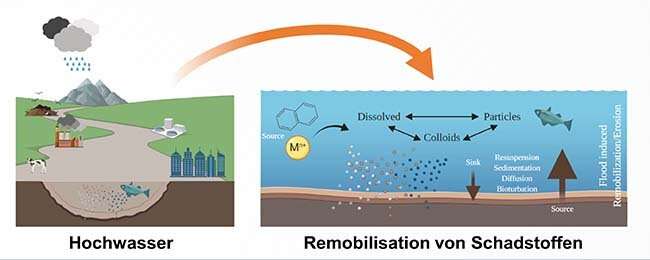Flood waters churn up toxins from riverbeds

Sediments are regarded as a river's long-term memory. They mainly comprise particles that are eroded from the ground, ending up at some point in river deltas or the sea. However, sediments can also remain stable for a relatively long time—and bind pollutants which, for example, have entered the rivers through mining or industrial wastewater. As a consequence, many old river sediments contain pollutants as "chemical time bombs," such as heavy metals or dioxins and dioxin-like compounds that are not easily degradable.
During flood events in the more industrial regions of Europe, North America and Asia, old sediments can be churned up as a result of the high speeds at which the water is flowing. In the process, the pollutants bound in them are regularly released in one go and contaminate flooded areas. An interdisciplinary team of researchers from Goethe University, RWTH Aachen University and the University of Saskatchewan in Canada, along with other partners, has compiled a review of previous scientific studies on this topic. In it, the researchers, headed by junior research group leader Dr. Sarah Crawford in Frankfurt and Canadian researcher Professor Markus Brinkmann, show, for example, which pollutant loads were measured after various flood events, which test systems were developed for different pollutants and how different sediments behave when water flows at high speeds. It describes the risks for drinking water production, the influence of temperature on pollutant intake by fish and methods for assessing the economic costs associated with the remobilisation of pollutants.
Despite the many years of research on this subject, Henner Hollert, professor of environmental toxicology at Goethe University and senior author of the publication in hand, is greatly concerned: "I have the impression that the problem of pollutants from old sediments is greatly underestimated in Germany and also in Europe as a whole. One reason for this could also be that to date there have been practically no studies at all on the economic consequences of this problem, as we've been able to show. However, contaminated sediments are a ticking time bomb that can explode each time there's a flood. What we need now is good river management across the board that not only looks at immediate hazards for humans, animals and infrastructure but also at the long-term consequences resulting from pollutants in the riverbeds. It's imperative, for example, that we examine flooded areas used agriculturally for river-specific pollutants so that these do not end up on our plates in the form of meat and dairy products."
In an interdisciplinary approach, researchers from Goethe University Frankfurt, in collaboration with RWTH Aachen University, the University of Saskatchewan in Canada, the Helmholtz Centre for Environmental Research in Leipzig, the Institute for Social-Ecological Research (ISOE), the Senckenberg Institute, the LOEWE Centre for Translational Biodiversity Genomics and many other partners, are also studying the recent extreme flood events in Rhineland-Palatinate and North Rhine-Westphalia in terms of hydraulic engineering and the biological, ecotoxicological, ecological, geoscientific but also the social-ecological and economic consequences. These studies are embedded in the new research cluster RobustNature at Goethe University, which is examining the robustness and resilience of nature-society systems in the changing Anthropocene and aims to contribute to knowledge-based transformation research using the examples of biodiversity and water—that is, from knowledge to action.River sediments, a dynamic reserve of pollutants
No comments:
Post a Comment